Anime Review: Irozuku Sekai no Ashita kara
- Joseph Lutholtz
- Feb 23, 2019
- 12 min read

Common Name: Irozuku Sekai no Ashita kara
Alternative Names: From the Color-Changing World's Tomorrow, Iroduku: The World in Colors, Iroduku
Score: 7/10, 5/5
Length: 13 Episodes
Genre: Romance, Drama, Magic, School Life, Slice of Life
Summary: In the future, magic has become nearly indistinguishable from technology as it is used to do everything from painting the sky with firework-like displays of colors and design to the kinds of services we expect from smartphones. Yet, magic does not always bring happiness. Magic has only brought Tsukishiro Hitomi sadness as it has torn apart her family and afflicted her with a curse that forces her to only see things in monochrome. Yet, hope is not lost. Hitomi's grandmother, Kohaku, has been constructing a spell that might break this curse and give Hitomi a chance at a happier life. With luck, this new and untested spell will send her 60 years into the past, back when Kohaku was still in high school, where she will find the clue she needs to break the spell that has plagued her since childhood.
Review: Over the past couple of seasons, I think something has started to dawn on me. The older I get as an anime fan, the more predictable shows get. Normally, this isn't a problem, considering how the industry is built on creating variety and tweaking things here and there to keep old ideas fresh, but the romance genre, in particular, seems to struggle with this in a strange way. On the one hand, romances often follow a formula that is very easy to read. Just by looking at the archetypes the show has built into its cast, you can pretty easily tell who likes who and why. Usually, these shows lean on either the comfort of two similar people growing closer in their shared interest or the intrigue of watching opposites attract. Throw in a few love triangles that lean on the concept not being used for the main pair or one built on an established friendship and you've got the makings of your standard romantic drama. On the other, even when these stories are predictable, they usually still feature some quality writing that uses its characters well and concepts to their full effect. So long as there isn't so much drama infused into the story that it feels spiteful or cringe-worthy, it's generally pretty hard to mess that formula up. In spite of that being the case, though, I've found it increasingly frustrating whenever I watch a romance--one of my favorite genres--and end up connecting almost all the dots by episode two. To be clear, though, my frustrations don't necessarily mean I didn't enjoy this show. Rather, I really liked this show's characters and the overall plot. The romantic elements fit the story well and are used more effectively than some other formulaic titles I can think of. So, as much as it grated on me at times, the show's simplicity doesn't necessarily make it bad.

Quite the contrary since this is easily one of the most gorgeous show's I've ever seen. Like, this is up there with Magus' Bride with its levels of eye candy.
From the ground up, Irozuku is built as a celebration of color. From the main premise to the characters that keep the plot chugging, everything seems to speak to and supports the general idea that colors have a considerable amount of power. Particularly in the case of the show's main character, Tsukishiro Hitomi, colors are everything. Born in a techno-magical future where magic is used as an artistic medium to create brilliant, vibrant displays of color, the likes of which can only be seen in visual media and in own's own dreams, it is understandable that colors would be considered important to her. All the more so when you consider that she is the granddaughter of a renowned mage. Yet, in spite of her history and upbringing, Hitomi stands as an outsider in both her culture and family. Though she has magical abilities, she professes to hate magic and rightfully so. After all, ever since she was a child, magic has only brought her pain and suffering. It tore her family apart and has landed her with a curse that would immediately isolate her from anyone else around her. Specifically, she is afflicted with a form of colorblindness so extreme that she can only see in monochrome. So, as a last-ditch effort to save her from this curse, Hitomi's grandmother, Kohaku, sends her back in time in the hopes that a new environment or even her younger self might be able to find a way to break the curse.

Considering how the show's time travel shenanigans exist in a closed loop,
however, it's made pretty clear that Kohaku is one crafty, old witch.
Almost immediately upon arriving the past, though, Hitomi gets into some trouble and has the rest of the show's cast inflicted on her. I say inflicted specifically because they all just kind of mob her, looking for an explanation of why she was seen climbing out of one of their windows, putting her in an unavoidably awkward situation. Rather than getting any kind of answer out of her, though--because who would believe that this weird girl is from the future--she's immediately just labeled as a good person and is absorbed into their color-coded friend group full of photography enthusiasts and a lone artist. Simple as that, the cast is introduced, Hitomi is set on her path of friendship and self-discovery, and she's given something to do while she's trapped in the past. More importantly, though, not long after meeting this friend group, she meets someone who might very well be the key to lifting her curse--the aforementioned artist, Aoi Yuito. For any reason that could range anything from true love to fate or merely just a convenient plot contrivance, Hitomi is somehow only able to see colors when she looks at Yuito's pastel works of art. Catching him in the park while he's trying to work through an artistic block, Hitomi finds herself immersed in a world of colors that resembles a children's picture book. While this moment ultimately ends up being just an illusion born of her repressed magic going haywire, it is still the most beautiful sight Hitomi has ever seen in all her life.

And thus begins the romantic cat and mouse act that will go on for the entirety of the show's runtime.
For the majority of the show, these two serve as the primary perspective characters as they both cautiously try working through each other's problems. Obviously, Yuito's art sets him apart from the rest of the cast and offers Hitomi some hope that her curse might be lifted one day. For her part, though, Hitomi works to encourage and inspire the struggling artist to break through his creative block and become the great artist people are expecting him to be. Of course, this development also labels them as the show's primary romantic pairing, fueling a romantic arc that is full of pauses and conflicts born simply from the fact that they are both terrible at communication. Hitomi, understandably, is shy and awkward due to her being an "other" in more ways than one. Yuito, on the other hand, just doesn't really know what to do with his feelings since he's never fallen in love before. On and on, back and forth, these two progress the story with a dramatic and romantic arc that plays out like the slowest game of Pong the world has ever seen. Though it ultimately ends well, it takes a long time to get there, leaving the rest of the show open to inflict us with a lot of unnecessary drama.
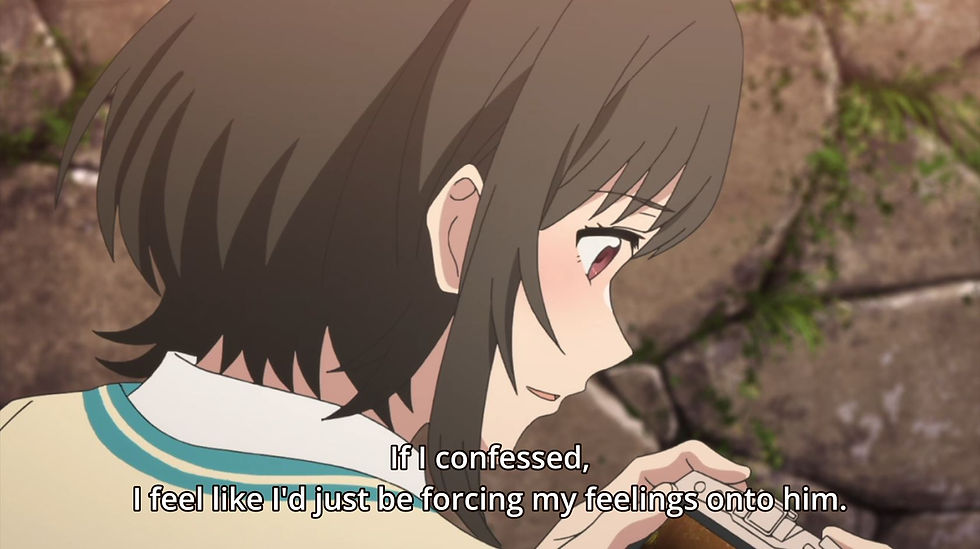
Oh boy, do I know that feeling and hate it with a passion.
While, yes, the story of Irozuku is mainly concerned with Hitomi's curse, Yuito's frustrations as an artist, and their shared growth as individuals, the actual bulk of the show is made of the rest of the cast's personal and romantic drama. Most notably, it is filled with the drama born of an unrequited
love triangle that's just kind of inflicted on Hitomi since she is both foreign to the group and not officially romantically entangled with Yuito just yet. To speak in broad strokes, this arc of the show centers around two childhood friends within the photography/art club Hitomi joins in an attempt to know Yuito better. Kazano Asagi, a shy and unambitious girl, has very obvious feelings for her outgoing friend and mentor, Yamabuki Shou. Going through the standard worries that being in a relationship might destroy their friendship or that she's simply not good enough for him, Asagi repeatedly pushes her feelings down in an attempt to maintain the status quo. Meanwhile, Shou, either because he's too dense to notice her feelings or is just exploring another avenue while Asagi works up the courage to actually confess (the show never actually commits to one or the other), has set his sights on Hitomi because he feels some need to protect her like he's done for Asagi for years now. Having only just started off as friends, this development obviously creates a rift in the group as Asagi anguishes over her weakness and Hitomi is barraged with feelings and interpersonal conflicts she is by no means equipped to deal with, let along resolve. Yet, against all odds, she manages to diffuse the situation without causing irreparable damage to her new friend group.
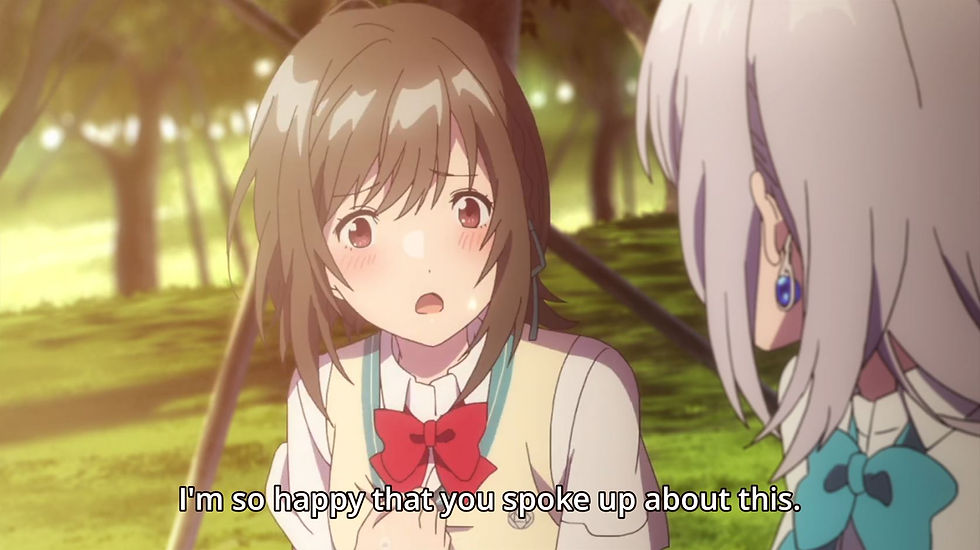
If anything, she an Asagi become better friends once they've aired everything out.
Thankfully, the rest of the show's interpersonal drama doesn't drag the emotionally stunted Hitomi into their problems. In fact, the other main romantic pairing of the series just kinda deals with itself. Plagued with inferiority complex born of her constantly comparing herself with her older sister, Kawai Kurumi, a senior in the photography arts club, gets a couple episodes dedicated to her learning to be more comfortable with who she is and to not stress about not having a driving goal in life just yet. Yet, unlike the romantic feuding and agonizing that plagued Asagi and Shou's arc, Hitomi has very little to do with Kurumi's problem beyond just being a shoulder to lean on. Rather, Kurumi learns to move past her hangups after a pep talk from the club's youngest member, Fukazawa Chigusa. Also unlike Asagi and Sho's relationship, Kurumi and Chigusa's develops a lot more organically and competently. Having known Kurumi for some time now, Chigusa has the social awareness to recognize when something is eating at his mischievous and perky senpai. Also knowing that it's not his place to insert himself into her problems, he simply takes steps to unintrusively egg her on and encourage her as a friend. Essentially, he just gives her the encouragement and space to figure out her problems in her own way, revealing just how much he cares about and respects her. This interaction paired with their humorous and often flirty banter, these two easily slide into their role as "best support couple."
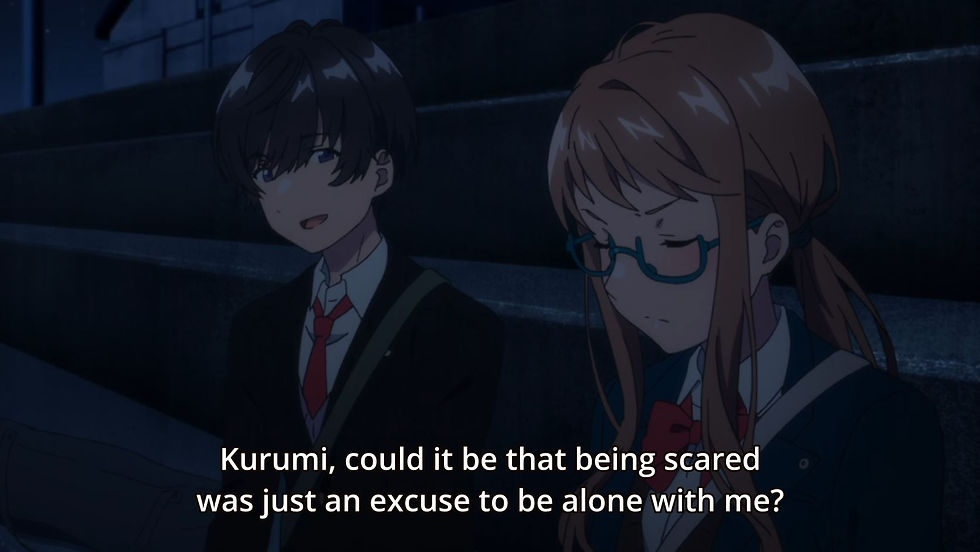
It's criminal that these two don't get a larger role beyond being the only people sentient enough
to see when and how problems are going to crop up, mitigating it before it gets too bad.
Alright, that quip isn't exactly fair since there is one other member of the cast with enough perception to notice when things are going on. Kohaku or, rather, Teen Kohaku is easily one of the show's most fascinating characters. Where most of the cast has an archetypal gimmick that defines them, she almost comes off as a bit of a Mary Sue simply because she carries aspects of the entire cast. She's strong and determined, like Shou. She's cunning and a bit of a smartass, like Chigusa. She's mischievous and insecure in her powers, like Kurumi. She has her meeker moments when the chips are down, like Asagi. And, of course, she bears some inner hesitation when it comes to magic since she knows how dangerous it can be, like Hitomi. Yet, in spite of showing similar aspects to the rest of the cast, she manages to be her own person with her own set of problems--albeit problems that are directly related to the general Hitomi problem. Almost immediately upon her arrival to the series, she takes on her role as Hitomi's magical instructor, hoping that perhaps that the curse is tied to Hitomi suppressing her innate magical abilities. Without so much as batting an eye, she accepts Hitomi's story and becomes her greatest confidante as she tries to navigate her feelings. Underneath all of her outward confidence and tomfoolery, however, it becomes clear that she's far from perfect. Skilled as she is at magic, she's terrified of what might happen if she botches the job when they have to send Hitomi to her own time. Up until now, she hasn't even tampered with time magic but she's still been tasked by her older self to get the job done and that understandably worries her to no small degree. Yet, just like how Hitomi gains confidence by interacting with the photography art club, Kohaku also learns to lean on others more and ask for help when she truly needs it.
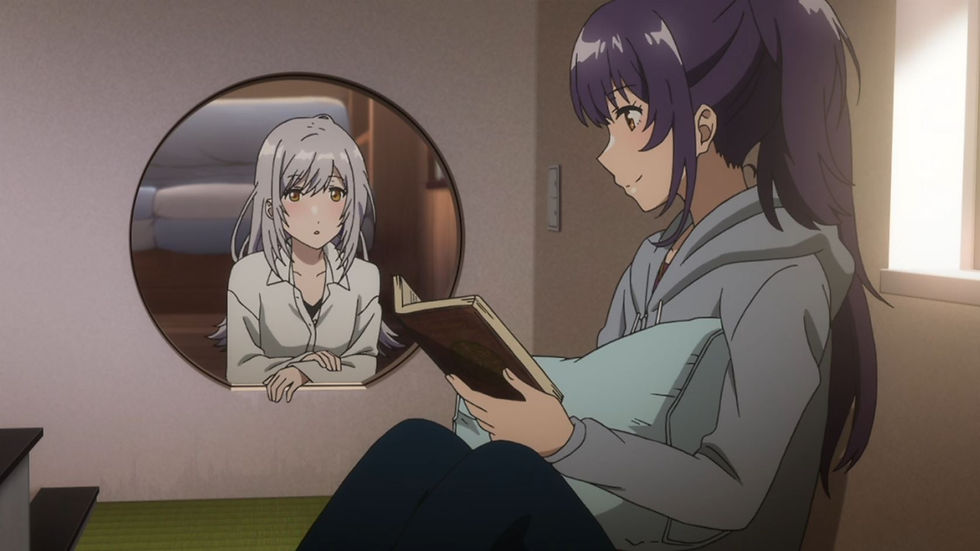
She is an absolute treasure and, hands down, my favorite character in the entire series.
Unfortunately, as much as I love this show's characters and how all their little quirks work to form a group of friends I can totally see working, I often found that the story itself just didn't do them all justice. As I said in my quip, Kurumi and Chigusa are functionally nonexistent as characters and are only given roughly an episode and a half to really flesh out their personalities. For the rest of the show, they're reduced to being tricksters that keep the plot moving or supports that help the rest of the cast deal with their problems. Similarly, a lot of the drama and magical nonsense that fills both Kohaku and Hitomi's stories often feel like thinly veiled contrivances that crop up once and are swiftly discarded. For instance, to signal that the show needs to wrap up, Hitomi starts to undergo a sudden new phenomenon that wasn't even remotely alluded to until now where she just suddenly vanishes for an unspecified period of time and returns without realizing that anything happened. This scare is used as a means to get Kohaku to take her job a lot more seriously and makes everyone come to terms with the fact that Hitomi might not be around forever. Yet, after a couple of these scares, this plot point doesn't really ever come up again except to give us one last contrivance before she gets sent home. Yet, that's kinda the nature of Hitomi's story as a whole. Though it's all fairly well justified, a lot of Hitomi's story centers around things happening to her and around her just because she's the vehicle of this show's story. Everything that happens in her story from the curse and her time travel to her becoming the center of a friend group's drama and her eventual breaking of said curse just kinda happens without her involvement whatsoever. She's the crux of this story but does little to nothing on her own to warrant that place in the story beyond being an outsider.

As poignant as a feeling as that might be, Hitomi just doesn't have
the presence to really do anything with it.
This, of course, doesn't mean I dislike Hitomi. Quite the contrary, I felt for her as she soldiered her way through situations she just wasn't equipped to handle. In many ways, she reminds me of Violet from Violet Evergarden in that both she and Violet exists as emotionally stunted individuals. It's only until later in the series that she starts to show some drive and the initiative to actually want things but the show only proceeds to smash those dreams. As I've said several times already, this show is built on things just happening to Hitomi and that fact just ended up galling me to the drama it had to offer. Both in her overall situation and when it comes to romance, Hitomi ends up being inflicted with other people's feelings and situations that she just can't rightfully deal with. Shou's unsolicited feelings for her and the drama that causes are a perfect example of what I'm talking about. Her already fragile friendships and ties to this world are threatened purely because one guy is either too dense to notice the feelings of someone right next to him or is an absolute bastard for manipulating her to provoke Asagi's character development. Yet, just like Shou, the show's plot does much the same damage, crushing Hitomi's happiness with the time gap nonsense just as she is starting to realize her feelings for Yuito. As the show's main character, it stands that Hitomi would be a target for a lot of contrivances and drama but it feels off when its targeted at her, rather than anyone else. For someone like Kohaku, these kinds of events work because they challenge her to overcome a problem she's capable of handling. For Hitomi, it feels almost abusive since she lacks the kind of power and confidence. While she obviously still gets through things and grows in the process, she only ever succeeds because she's being supported by a cast of characters willing to shoulder that pain with her. So, as a result, we end up with a show full of wonderful characters dealing with a less-than-stellar story.
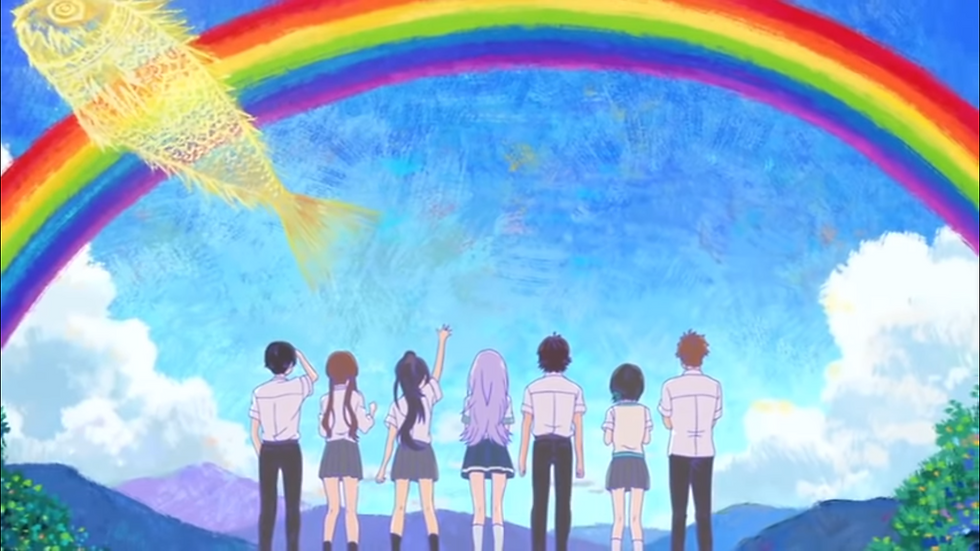
At least this show's stellar art makes that less-than-stellar story more bearable.
Now that my main grievance has been clearly stated, though, I can say without reservation that I still love this show in spite of its flaws. True as it might be that I saw everything coming early on, the show's cast still makes the journey worth the effort. Even when it comes to Asagi and Shou, regardless of how much I complain about their arc, I can't say I don't like what they add to the show beyond their dramatic baggage. On the whole, Irozuku is just a wonderful character story about growing up and learning to be more confident in yourself that is realized via a celebration of color. While I might have liked more segments from Hitomi's monochrome perspective to bring that message home more easily, her curse serves as a wonderful artistic touch that really expresses how wonderful the world can be when we open ourselves up to it. Sure, it's full of drama and can be scary at times, as the show makes abundantly clear, but the world really lights up and becomes a thing of beauty whenever she gets the rare opportunity to see things the way most people do. So, in case my feelings aren't clear enough, I have to recommend this show. It's a bit simple as well as forced and sloppy at times but it ultimately turns into a wonderfully unique and gorgeous work when all is said and done.


Comments